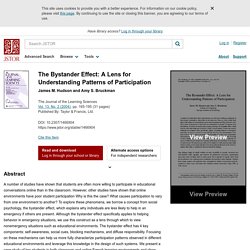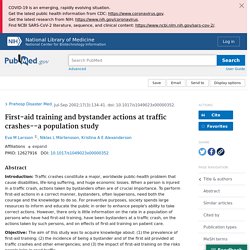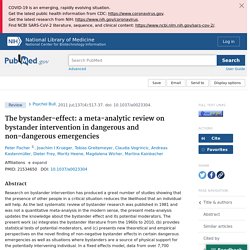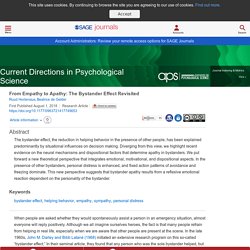

We share several tips on how you can counteract the bystander effect. Read on! :) Definition according to the APA Dictionary of Psychology. Social experiment on the bystander effect (emergency situation) Multiple scientific studies on the bystander effect. The bystander effect observed in a school setting (non-emergency situation) James M.

Hudson and Amy S. Bruckman The Journal of the Learning Sciences Published By: Taylor & Francis, Ltd. Cite this Item Abstract A number of studies have shown that students are often more willing to participate in educational conversations online than in the classroom. Journal Information The Journal of the Learning Sciences provides a multidisciplinary forum for the presentation of research on learning and education. Publisher Information Building on two centuries' experience, Taylor & Francis has grown rapidlyover the last two decades to become a leading international academic publisher.The Group publishes over 800 journals and over 1,800 new books each year, coveringa wide variety of subject areas and incorporating the journal imprints of Routledge,Carfax, Spon Press, Psychology Press, Martin Dunitz, and Taylor & Francis.Taylor & Francis is fully committed to the publication and dissemination of scholarly information of the highest quality, and today this remains the primary goal.
Case study: Kitty Genovese, James Bulger and the bystander effect. More than half a century later, the death of Kitty Genovese continues to remind us of the disconnect between what we believe about ourselves and how we really act under pressure.

The murder of the 28-year-old outside her apartment in the Queens neighborhood of Kew Gardens in the early morning of 13 March 1964 rippled through New York City and around the world. How could a young, independent woman who lived on her own terms be so easily struck down? How could so many neighbors look on and turn away as she was stabbed repeatedly on the street and in her apartment building? What did that collective inability to act reveal about ourselves, our communities, and our belief systems? Genovese’s killer, Winston Moseley, died in prison this week, bringing the case and its implications back into the spotlight. Two weeks after her murder, Rosenthal assigned a story with the damning headline: “Thirty-Seven Who Saw Murder Didn’t Call Police.”
Latané and Darley’s (1968) Stages of Helping. Identify signs of an emergency using your senses. Factors and conditions of the bystander effect in an emergency situation. Overview of factors. Function of Group Size.
The graph shows that as the group size increases, the likelihood of intervention decreases. This demonstrates diffusion of responsibility, which refers to the dilution or weakening of each group member’s obligation to help or become personally involved. (Darley & Latané, 1968 ). – sankariri
Diffusion of responsibility in the bystander effect. Read up more in this book: The Unresponsive Bystander: Why Doesn't He Help? Subject Competence and Minimization of the Bystander Effect - Cramer - 1988 - Journal of Applied Social Psychology. First-aid training and bystander actions at traffic crashes. Introduction: Traffic crashes constitute a major, worldwide public-health problem that cause disabilities, life-long suffering, and huge economic losses.

When a person is injured in a traffic crash, actions taken by bystanders often are of crucial importance. To perform first-aid actions in a correct manner, bystanders, often laypersons, need both the courage and the knowledge to do so. For preventive purposes, society spends large resources to inform and educate the public in order to enhance people's ability to take correct actions. However, there only is little information on the rate in a population of persons who have had first-aid training, have been bystanders at a traffic crash, on the actions taken by such persons, and on effects of first-aid training on patient care. Methods: A questionnaire was administered to 2,800 randomly selected persons aged 18-74 years. Results: The response rate was 67.5%. Bystander intervention in dangerous and non-dangerous emergencies.
Research on bystander intervention has produced a great number of studies showing that the presence of other people in a critical situation reduces the likelihood that an individual will help.

Increasing the chances of helping behaviours. Having Morality, Civility, Integrity and Ethicality (M.I.C.E)
This interesting talk shares many tips on how bystanders can intervene - Morality, Civility, Integrity and Ethicality (M.I.C.E) - Notice > Interpret > Assume responsibility – sankariri
Dispositions play a part in how we respond. When people are asked whether they would spontaneously assist a person in an emergency situation, almost everyone will reply positively.

Although we all imagine ourselves heroes, the fact is that many people refrain from helping in real life, especially when we are aware that other people are present at the scene. In the late 1960s, John M. Darley and Bibb Latané (1968) initiated an extensive research program on this so-called “bystander effect.” In their seminal article, they found that any person who was the sole bystander helped, but only 62% of the participants intervened when they were part of a larger group of five bystanders. Following these first findings, many researchers consistently observed a reduction in helping behavior in the presence of others (Fischer et al., 2011; Latané & Nida, 1981).